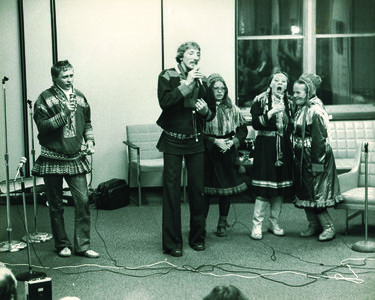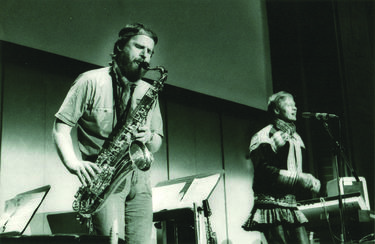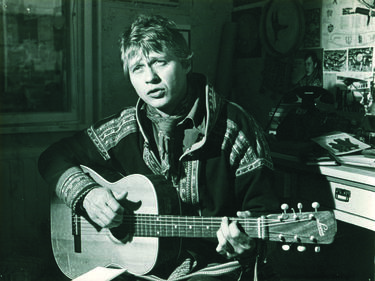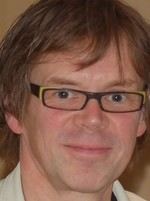
His debut album “Joikua” from 1968 was a revolution. Among the younger generation in Sapmi Valkeapää attained near rock star status and became the guiding star in the Sami cultural and political awakening throughout the 1970s. Before Valkeapää yoik was vocal music performed in private contexts. With “Joikua” he added musical instruments and sound effects and took the yoik to the concert stage. But it did not happen without a fight from the establishment, first from the believers. For them all yoik was sin. That did not bother Valkeapää. On the contrary, he foresaw, entirely correctly, that the ban would only get others to yoik. The hardest resistance came from those he called “cultural romantics” who castigated him for falsifying pure yoik.
In my conversations with Nils-Aslak he stressed how important it was to fight the traditionalists and make yoik a contemporary expression. If Sami culture was to avoid becoming a museum artifact it had to be in continual development. Only that way would it find its place in time and have something to present to people of today. Therefore, he was indeed in favor of elevating yoik from the campfire and family gatherings onto the stage, and at the same time allowing yoik to meet other musicians and musical genres.
On the debut album Valkeapää cooperated with the Finnish classical composer Kari Rydmann and the musician Martti Niskala. It was a genuine experiment where he subjected yoik to outside influences. And it passed the test. His yoik was strong enough. It was neither watered down nor mishandled. On the contrary, it became modern.
Valkeapää was himself somewhat reluctant to call his music “modern yoik.” He thought that traditional yoik lay so solidly at the base of everything he did that it appeared odd to call it something other than yoik. But with a twinkle in his eye to tease his opponents he found out that if he said modern yoik, then they could neither call his yoik sinful or falsified. It was indeed modern.

The next giant stride Valkeapää took in the development of modern yoik came with the album trilogy “Sápmi lottázan” that consists of “Sami eatnan duoddariid” (Sapmi’s mountain plateaus) from 1978 and “Sápmi, vuoi Sápmi” and “Davás ja geassái,” both from 1982. With the trilogy Valkeapää found his now recognizable form. In these years he was in an exceptionally creative period, open to impulses from classical and jazz, but also from other corners of the world.
“Sami eatnan duoddariid” especially contains several yoiks that have become classics. The title cut is often referred to as Sápmi’s other national anthem. The trilogy came into being in close cooperation with the saxophonist Seppo Baron Paakunainen and Esa Kotilainen on keyboards. Both were among the most well known jazz and rock musicians in Finland. Baron was the musical leader of Valkeapää’s group, and Valkeapää was careful to share the honor with him for having created modern yoik. Without Baron “my life would have been different, also Sami music culture,” he wrote.
The milieu around Valkeapää in these years was a huge epoch-making creative workshop. He became attached to several new musicians and yoikers, especially the then young yoiker Ingor Ántte Áilu Gaup.
Tradition and new creation is the red thread through everything Valkeapää does in these years: what is exceptional with the experimentation is that the bolder Valkeapää became at bringing in new musical elements from the outside the more he at the same time sought back to tradition. Both in 1977 and in 1981 he was with reindeer herding Sami on their spring migrations. In the notes that accompany the album “Davás ja geassái” (1982) he writes that these migrations became a prerequisite for developing not only modern yoik but also his poetry and pictorial art. The trilogy is his “Sgt. Pepper.” A musical turning point and milestone.

That Valkeapää would manage to develop further after such a great artistic effort is almost miraculous, but the double release of “Beaivi, Áhcázan” (“The sun, my father”) from 1988 and “Eanan, eallima eadni” (“The earth, my mother”) from 1989, composed together with his other faithful collaborator, Esa Kotilainen, is, just as the trilogy, a turning point: Two large monumental epic yoik works. Here Valkeapää reaches his highpoint as a yoiker. “Beaivi, Áhcázan” is music to the book for which he received the Nordic Council’s literary prize, while “Eanan, eallima eadni” is music to the sequel, or the twin of the prizewinning book.
Valkealpää never stopped experimenting. In 1994 came “Goase Dusse” (the Bird symphony). A unique work where the sounds of nature are put together as if they were musical instruments, a continuation of the natural sound experiment we heard first in the album “Sápmi voui Sápmi” (1982).
Valkeapää’s last disc was the powerful “Dalveleaikkat” (“Winter Games”) with his collaborator and a new young yoiker, Johan Anders Bær. This album shows how Valkeapää was steadily developing as a yoiker. It contains among other things the moving and powerful opening yoik he performed when he opened the Winter Olympics at Lillehammer in 1994. A few years before that Valkeapää also wrote music to Nils Gaup’s film “Veiviseren” (“The Pathfinder”).
However the automobile accident in 1996 put a stop to further releases. He had plans for several new projects, among others a CD with spiritual songs with his own texts to old psalm melodies he got from recordings in the Tromsø Museum collections. A live recording from Målselv church and Kautokeino from 1992 which was not actually intended for release nevertheless came out a couple years ago and shows what power he could put into traditional Christian songs.
Valkeapää died in 2001. We are many who miss him greatly. But even if he is gone he is here nonetheless, just in another form through his timeless art. He had a conviction that there are sounds that go from eternity to eternity. I believe that in much of his art he reached out to find these sounds that united him as a person with nature. Therefore death was never frightening for Valkeapää. For as he wrote in ”Beaivi Áhcázan”: “and when everything is over/nothing is heard any more /nothing/ … /and it is heard.”

Om artikkelforfatteren
Per Kristian Olsen er journalist og regissør i NRK. Han har det siste året laget to dokumentarfilmer med samisk tema, Vendepunktet og Tilbakeslaget. Han har også laget en rekke andre dokumentarer fra kunst og kulturområdet, blant annet Norsk rocks historie. For NRK P2 har han de siste to årene produsert 20 programmer i serien Klassiske norske rockealbum. Han har også gitt ut flere bøker. I fjor var han bidragsyter til NOPAs jubileumsbok, «Sangen om Norge» der han skrev en stor artikkel om samisk musikkhistorie. Om Nils–Aslak Valkeapää har han også laget flere radioprogrammer, holdt foredrag og skrevet artikler. Gjennom mange år har han som journalist fulgt utviklingen i samisk musikk.
Foto: NRK.





